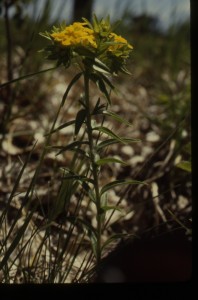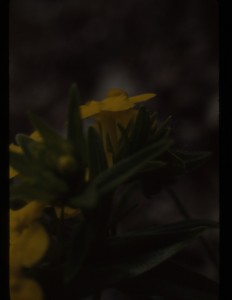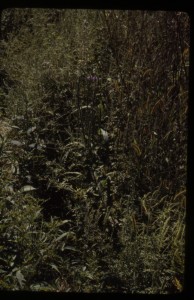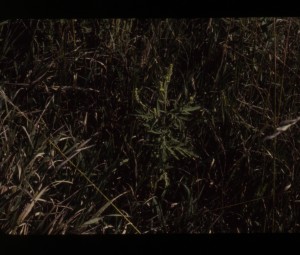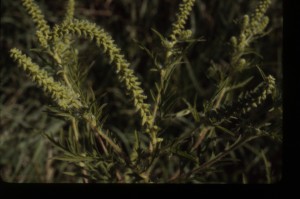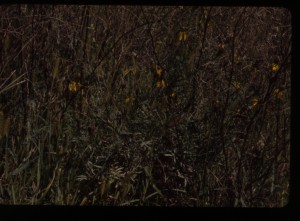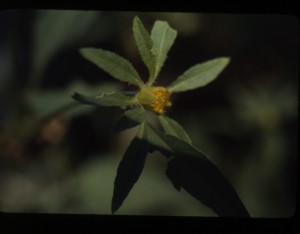Script for Muskenthie Slide Show
Slide 1 Muskenthine Sign
Sunday Afternoon, August 29, 1979 I took my Nikon F2 camera with a 28 to 105 zoom lenses out for a walk to the Muskenthine NRD Multi-Use area north of Stanton, Nebraska. This is a 740 acre piece of land with a 100 acre lake used extensively forfishing, boating, swimming, water skiing, flood control, and considerable area the NRD maintains for conservation and recreation. Camping is allowed for a small fee. Elkhorn Valley Cycling Club has it’s mountain bike trail there. Today there is an excellent arboretum on the East side with about 100 labeled trees. The area has changed considerably since 1979 with the recreational facilities and camping greatly expanded. The plants you are about to see were those plants my camera and I met on a three hour hike that Sunday afternoon. They were all very gracious and allowed us to take their pictures. The weather was sunny and about 85 degrees F.
The first plant is a rather coarse grass that grows as a common weed in our area, Orchard Grass. I do not have it’s scientific name, and am using the name my father taught me. It grows up to nearly three feet high, very straight and proud. It does not clump, but is quite invasive.
Slide 3 Big Blue Stem Grass – Andropogen furcatus Muhl. (A. Gerardii Vitman.)
 This is Big Blue Stem Grass. This magnificent plant grows from 6 to 12 feet tall and once so covered the tall grass prairie that covered wagon children could become permanently lost in it if the parents were not constantly on the alert. In its hay day, a horseback rider could also easily become lost in the grass, taller than he sat. Today it is mostly found in swails, CRP land, and some ditches. Big Blue’s root will push over 20 feet into the prairie clay and over years rehabilitate soils. Big Blue is named for the slightly blue cast to a lush growth. In the fall the foliage turns a beautiful deep maroon red. It is also called Big Turkey Foot for the curious shape of it’s seed head. Beautiful as it is, be careful with it in a garden, as it is very invasive spreading widely by root and seed.
This is Big Blue Stem Grass. This magnificent plant grows from 6 to 12 feet tall and once so covered the tall grass prairie that covered wagon children could become permanently lost in it if the parents were not constantly on the alert. In its hay day, a horseback rider could also easily become lost in the grass, taller than he sat. Today it is mostly found in swails, CRP land, and some ditches. Big Blue’s root will push over 20 feet into the prairie clay and over years rehabilitate soils. Big Blue is named for the slightly blue cast to a lush growth. In the fall the foliage turns a beautiful deep maroon red. It is also called Big Turkey Foot for the curious shape of it’s seed head. Beautiful as it is, be careful with it in a garden, as it is very invasive spreading widely by root and seed.
Little Blue Stem is in the same family as Big Blue, but much smaller and currently is set in a different genus. We have over 15 species of Blue Stems in Nebraska. This is a bunch grass planted by Nebraska Department of Roads. We have all seen its characteristic 30 inch tall and 6-12 inch diameter red clumps in the road sides. It is very attractive in the garden, with several different cultivars available giving an excellent vertical, but not too tall accent. I have not found it to be invasive.
Slide 7 Cottonwood Tree – Populus deltoides Marsh.
Our wonderful native cottonwood tree which we all love for the beautiful late May or early June snowstorm of its seeds in their white fluffy parachutes flying out by the millions, coating cars, roads, sidewalks and trails. It was extensively planted in the early tree claims. Many of those specimens are now reaching the end of their lifespan of 80 to 100 years and falling in the wind. The tree grows to 70 to 80 feet tall with a wide spreading crown of heavy thick limbs which can cause as lot of damage as they fall. This is an infant tree specimen, just getting started growing. P. Deltoidus, our cottonwood, has a cousin in the Southwest with linear leaves, which is native to wet spots in the desert, and which does not grow quite as large. It also makes the desert white with its seed’s parachutes every spring.
Slide 8 American Elm – Ulmus americana L.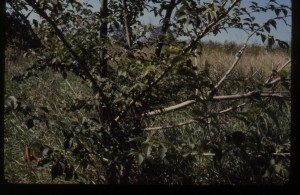
The wonderful elm, here most likely represented by an American Elm. It was a true disaster when the Dutch Elm Disease swept through and denuded our streets, which had been pleasant shady tunnels under the over arching 80-100 feet high canopy of the elms. Slowly cultivars are being developed that are resistant to the Dutch Elm Disease, so we may see a return. The elms tend to be weedy. Especially the alien elms, the Siberian and the Chinese, are apt to take over corners of pasture or orchards with hundreds of seedlings. I remember as a boy plucking scores of the discarded skins of the locust or cicada they left clinging to the bark of the trunks of the elm trees as they climbed up to serenade each other to find mates. Don’t leave your car sitting under an elm tree in flower. The dripping sap will ruin the car’s finish.
Slide 9 Boxelder Tree – Acer negundo
Acer negundo, Not the black maple. This is not a neat, nicely shaped tree, like our more common maple species, but is more often misshapen, twisted and knurled. It tends be a little dirty with its maple like helicopter seeds in the late spring. While often found on old farm steads, providing interest, by it’s shape, it is losing favor and reputation due to its unsightly gray tortured looking bark, and its twisted and untamed branches. It tends to be brittle, and often bears scars of lost limbs. The black maple can be considered the black sheep of the maple genus, Acer. But I like it and and if time permits always go over to visit it when I see it.
Slide 10 Snowberry – Symphoricarpos occidentalis L. 
Called by at least four names, and often confused with similar species, snowberry, coral berry, wolf berry or buck brush is a short understory low shrub, perhaps 30 inches tall in good conditions, commonly found in the dry woods natively in our area. The flower is white to pink and rather inconspicuous, and as a honeysuckle, tends to be born in clusters on reduced spikes along the stems. The fruit is paired or clustered distinctively along the stems like the honeysuckle it is. The group is called buck brush as the deer will eat the young branches in the winter when other food is scarce. So it is a measure of winter forage quality for deer.
Slide 11 Wild Prairie Rose – Rosa sp. 
One of the several species of prairie rose, native to our prairies and a pretty addition to any field or pasture. The hips, or seed pods are very similar to that other rose family fruit, the apple, and are high in Vitamin C. While it tends to be difficult to transplant, it is occasionally found in hedges, the seeds having been eaten and defecated by birds. An excellent tea can be made from the hips, the flowers or the leaves, but care must be taken not to overheat or the vitamin C is destroyed.
Slide 12 Jewel Weed – Impatians pallida Nutt. 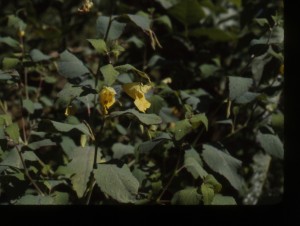
This pretty little jewel of a flower is aptly called jewel weed, or pitcher plant. The flower that looks like a little pitcher pouring water, is usually just over an inch long. Jewel weed loves to grow in moist soil, right along with various species of nettles. If one gets the nettles, one can crush the stem of this plant and apply the crushed stem to the area affected. The juice of the stem counteracts and relieves the sting of the nettles. I have seen it in large patches up to 5 feet tall with lots of the flower jewels on each plant. When seen in flower like that it is a real treat. One just has to avoid the nettles in the vicinity.
One of the many mint species found native to and invading our area. Nearly all them are aromatic, and flavorful, some more so than others. Mints are readily recognized by their square stem. Very few other plants have square stems. Exact identification to species is usually difficult, unless it is one of the “herb” varieties. Most any of them can be used in cooking or for tea. The leaves are opposite with the flowers in clusters in the stem-leaf joints, leaving typical mint stalks in the fall. Some of these can be used in floral arrangements.
Slide 14 and Slide 15 beebalm – Monarda fistulosa L. 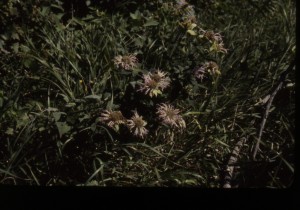
One of the mints, easily recognized by its peculiar flower shape is the beebalm or monarda. I believe it is native to area. There are now several cultivars available for the garden in several colors. I have usually found it on the edge of the woods, liking full sun, but with a little protection.
Slide 16 and Slide 17 Hoary Pucoon – Lithospermum canescens (Michx.) Lehm.
The hoary pucoon is common in our ditches. It has a cap of terminal, bright yellow flowers nearly covering the vase shaped, many stemmed, 6 – 12 inch plants. The flowers have a long yellow tube atop which is a sudden flaring outward of the petals. A single plant would make a beautiful bouquet easily held by its narrow base.
Slide 18 Smart weed – Polygonan sp.
 Smart weed or Pennsylvania weed is a common, low growing, weak stemmed plant with the terminal raceme of flowers and seeds. There are several species, difficult to separate. Smart weed will drape itself across other plants and fences, but is not truly a vine. It have seen it in very wet places and in very dry places. Supposedly it is edible, but I am not sure it has any nutrition value.
Smart weed or Pennsylvania weed is a common, low growing, weak stemmed plant with the terminal raceme of flowers and seeds. There are several species, difficult to separate. Smart weed will drape itself across other plants and fences, but is not truly a vine. It have seen it in very wet places and in very dry places. Supposedly it is edible, but I am not sure it has any nutrition value.
Slide 19 Curly Dock – Rumex crispus L.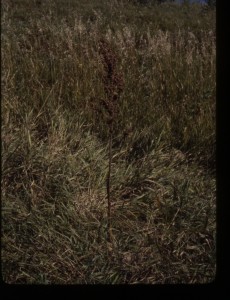
One of my favorite plants is curly dock. Its rosette of basal , light green leaves is easily identified by the curly nature of the leaves. The tall, often over 4 feet stem ascends and branches characteristically. This late in August, the plant is only a dried stalk, but still easily identified. This plant is very common in neglected pastures and open woodlands, standing out in it’s field by its heighth and seed stalk shape.
Slide 20 Ground Cherry – Physalis longifolia Nutt.
Ground Cherry is one of the nightshades, related to the tomato and the potato. Thus, it is probably poisonous. I call it the Japanese Lantern Plant due to the shape of its seed pod as a green ballon around a small central seed. The stems are weak and will grow a long way, twisting and turning, laying on top of its neighbors, to find light and space. If the plant weren’t so invasive, and potentially poisonous, and such a garden thug, the intriguing seed pod alone would justify it in the garden.
Slide 21 Common (Ruggle’s) Milkweed – Asclepias syriaca L.
The common or Ruggle’s milkweed is a tall, non branching, heavy leaved, invasive plant with a most interesting flower and seed pod. Like all milkweeds, the petals fold up and the sepals fold down giving an umbel of hourglass greenish to white flowers. The plant will grow up to nearly 5 feet tall, with the flowers in drooping clusters or umbels nearly 3 inches in diameter, coming from the leaf stem joints. Before the milky sap comes in, when the plant is about 6 inches tall, the leaves are edible as in a mixed green salad. I have never eaten them, but have been told they are very good with young dandelion leaves. Once the characteristic, thick milky sap starts, the plant is poisonous. In the old days, before commercial Christmas tree ornaments, and during the Depression, the seed pods of this plant were dyed or painted and used to decorate the Christmas tree. My grandmother had a large suitcase full of the milk weed pods she used just that way. Each of the multitudinous seeds has a large white cottony, plume which carries it on the wind for huge distances. Interestingly, the plant has a deep tap root. Pulling the plant will yield 2 – 12 inches of white underground stalk. The plant returns either that year or next, growing from its taproot.
Slide 22 Lead Plant – Amorpha canescens Pursh. 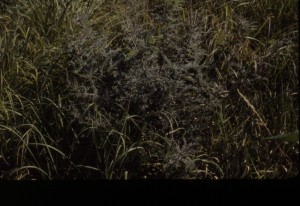
Lead plant is a plant named for the color of it’s foliage. It’s leaves are actually a gray lead color. The flower is blue, standard pea family flower,. It rather ball like appearance of gray and blue makes a rather attractive addition to any medium grass land. It is a member of the pea family. The grazers find it palatable and will eat it preferentially to many other plants that decrease with grazing. Undisturbed, The Flora of the Great Plains book claims it will grow to over 2 meters tall, but I have never seen it over 1 meter, most usually under 60 cm.
Slide 23 and Slide 24 Euphorbia marginata Pursh.
Snow on the mountain is an attractive annual herb in the same genus as the noxious weed, leafy spurge and closely related to the poinsettia. It tends to grow in lovely patches, about 18 – 24 inches tall and from a distance actually can look like snow on the plains. The stalks are usually single, many branching high up with its poinsettia like very small flower surrounded by huge very attractive leaves. There are several garden cultivars, but they can be weedy if the seed head is not removed before dispersing the seed. It likes the full sun of the open Great Plains.
Slide 25 and Slide 26 and Slide 27 Wild Cucumber – Micrampelis lobata (Michx.) Green-Rydberg
alt – Echinocystis lobata (Michx.) T.&G. 
Wild cucumber is a very smooth, glaubrous shiny vine with white flowers in a loose raceme, and nearly single round to ovoid attractive, weakly prickly fruit. I have found it in the open woods at Yellow Banks Wildlife Management Area, north of Battle Creek, Nebraska, and overgrowing old unkept wind breaks. It likes moist rich soil as found in river banks and also open woods. It can overtake and kill small trees. It has been cultivated for arbors, and has freely escaped in to the wild. Sometimes called wild balsam apple.
Slide 28 Slender Nettle – Urtica gracilis Ait-Winter (alt U. dioica L.) 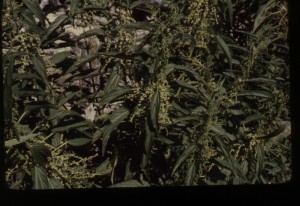
Slender Nettle is one of our three common nettles. The others are common nettle and broad leaved nettle. They all share the leaf spines and toxin bulbs that cause a hive like, severe itch shortly after contact. The two good things are that the rash and itch don’t last more than a few hours, and the antidote, jewel weed, grows in the same ecologic niche. The worst case I ever saw was a 16 year old teen boy, wearing a small speedo racing suit (He was a member of the school swim team.) who literally rolled accidentally down a steep bank through a large patch. In spite of some jewel weed and lots of cool water, he was in agony for about 4 hours. I have seen all three of the nettles grow to over 6 feet tall, making a nearly insurmountable barrier unless one is thickly and completely covered.
Slide 29 and Slide 30 Hoary Vervain – Verbena stricta Vent.
Hoary vervain is strongly vertical pasture weed, increasing in overgrazed pastures. Its attractive tall spike has only a few sky blue flowers at a time clustered along it. The flowers seem to grow down the stem, as the longer the stem above the flowers, the later the season. Once I had one invade my garden, brought in by birds. In the rich good soil and plenty of moisture, it grew to over 5 feet tall and spread over 5 feet with hundreds of the terminal seed spikes. In the normal pastures, it usually only stands 15 – 24 inches. The name vervain is also applied to several close relatives with garden cultivars. Most of these are low, creeping in nature with yellow flowers.
Slide 31 and Slide 32 and Slide 33 Tall Thistle – Cirsium altissimum (L.) Spreng. 
Tall Thistle is one of about 16 members of the Cirsium or thistle genus that grow in Nebraska. True to it’s name it can grow to over 7 feet. Only the musk thistle with its purple reflexed sepals and the Canadian thistle with its much smaller yellow flowers are actually noxious weeds in Nebraska. All thistles share similar flower heads and scatter many thousand of seeds on dandelion like parachutes from every plant. The success of the thistles and difficulty of killing them, causes land owners to spray indiscriminately with broad leaf killers, killing not only the thistles, but many other useful and attractive forbs in the grasslands. The Platte thistle is a smaller plant with white flowers from the Sandhills of Nebraska.
Slide 34 Wild Lettuce – Lactuca sp. 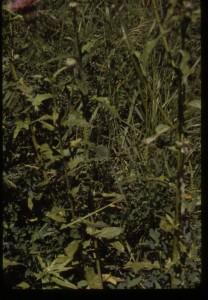
Wild Lettuce is a herbaceous biennial that is common in our ditches. I have not confirmed, but think that the tall blue flowered stems along highway 81 are wild lettuce.
Slide 35 and Slide 36 Horse Weed – Conyza canadensis (L.) Conq.
Horse weed is a tall, 3-5 foot, single stemmed, with the horse tail like inflorescence on top. It is rather weedy. It is common across the great plains, but not good for much.
Slide 37 and Slide 38 False boneset – Kuhnia eupatorioides L.
Another wild composite, a common weed in our area is false boneset. It grows in the open prairies and plains.
Slide 38 and Slide 40 Common Ragweed – Ambrosia artemisiifolia L.
This little plant, along with its relative, giant ragweed, is the major cause of fall hayfever. Too often we blame the goldenrods, but they do not spread pollen. Common ragweed will grow in and amongst the golden rod and let the bigger, more showy plant take the blame for the hayfever. Each plant spews out millions of pollen grains, each and every one working to find either another ragweed to mate with, or a nose to irritate. It grows from 1 or 2 inches to about 15 inches tall, and can be found in mats of thousands of plants, often hiding under other plants. Pre-emergents are probably the easiest way to keep it out of our gardens.
Slide 41 Goldenrod Solidago sp.
The Nebraska State Flower is the showiest of the goldenrods. Solidago is a confusing genus. Rydberg from Colorado, in the 1930’s listed over 75 species on the Great Plains. But he was a splitter, naming new genii and species where others saw the same plant with slight variations. Other authors list 20 to 30 species. Kaul, 1996, lists only 10 species in Nebraska. Many times an individual plant will be listed as a cross of known “species.” And now we are getting numerous cultivars that are considered more tame and less weedy. It can spread wildly. As above, under ragweed, this plant is an insect pollinated flower, and does not spew its pollens out to cause hayfever. It has a bad rap, but is a worthy state flower for its beauty and spread over most of the state.
Slide 42 and Slide 43 White Snake Root – Eupatorium rugosum. Houtt. (Alternate Ageratina altissima (L.) R. King and H. Robbins. )
White snake Root is an attractive flat headed crowded cluster of white flowers on 18 – 24 inch herbaceous plant flowering in August through frost. It grows in open uplands and lowland open woods. It is rather common in our area. The plant is poisonous to livestock who transmit the poison to humans as “milk sickness.” It is a white composite.
Slide 44 and Slide 45 Gray Headed Coneflower – Ratibida pinnata (Vent.) Barnh.
The cone flowers are a truly attractive yellow composite herbs, 2-3 feet tall, with a 1 to 2 inch long gray or brown cylinder protruding out from the base of the drooping yellow petals, thus “cone” flower. Some varieties have a red on the proximal ¼ of the petals. They grow in our pastures and grasslands. Recently there have been cultivars developed for the garden. They are native here. And with their very deep root system, over many years help rehabilitate our soils.
Slide 46 and Slide 47 Beggers tick – Bidens frondosa L.
Beggers Tick is another of the great ADYC group (another damn yellow composite). But this one is easily distinguishable by its unique seed long, flat with two awns. The seed sticks to clothing, fur, skin and is thus transported to new sites. A rather smallish herb with loose yellow petals, it is a pleasant find until one tries to remove the seeds from one’s clothing.
Slide 48 and Slide 49 Compass Plant – Silphium lanciniatum L.
One of the tall sunflowers standing tall in our ditches in the fall, Compass plant supposedly has it’s flowers on the four sides of its square stem, facing the cardinal directions. It has long very deeply toothed leaves, very large at the base of the plant, and smallish on the tall multiple stalks. Compass plant has the only true square stem outside the Mint family I know of. The other common tall ditch sunflower is probably the saw tooth sunflower, distinguished by its much narrower form and saw like appearance.
 The last five slides are species of sunflowers I encountered.
The last five slides are species of sunflowers I encountered.
Again, these are plants I met on a Sunday afternoon hike, August 29, 1979 in the Muskenthine NRD Multi-Use Area 3. miles north of Stanton, Nebraska, or 10 miles east of Norfolk, Nebraska. The group is totally eclectic in that I only took pictures of the plants I encountered on a rather random walk in the area. No claim for completeness or scientific selection is made other than all the plants were in the stages pictured on that day. For the record, all plants pictured agreed to having their pictures taken and to possible future public publication of such pictures.
Scientific identification was made by myself using primarily Peterson and McKenny, Field Guide to Wildflowers of Northeastern and Northcentral North America, 1968 and the Dover Reprint of Britton and Brown’s, An Illustratred Florea of the Northern United States and Canada, 1912.
Verification was done using Winter, “An Analysis of the Flowering Plants of Nebraska, April 1936, A Thesis presented to the Graduate College of the University of Nebraska in partial fulfillment of Requirements for the Degree of Doctor in Philosophy, Department of Botany, and Petersen, Flora of Nebraska, second edition, 1912.
Further analysis and name checking has recently been done with McGregor, Flora of the Great Plains, 1986, and Kaul, The Flora of Nebraska, 2006.
I take full responsibility for the correctness of the identifications and the choice of synonyms. Any errors are mine. Corrections are welcome.
September 26, 2011. Norfolk, Nebraska





